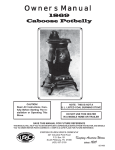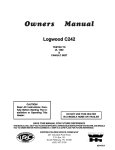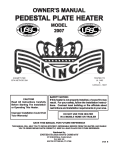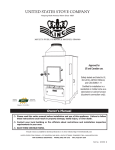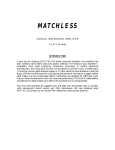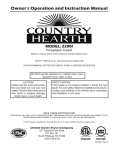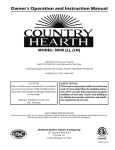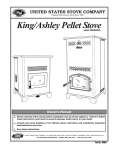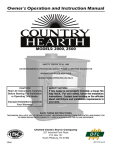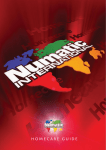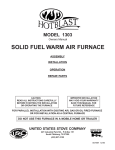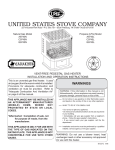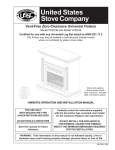Download United States Stove 1864 User's Manual
Transcript
Owners Manual 1864 Hasty Baker Range CAUTION! Read All Instructions Carefully Before Starting The Installation or Operating This Stove. NOTE: THIS IS NOT A U.L. LISTED COAL BURNING STOVE DO NOT USE THIS HEATER IN A MOBILE HOME OR TRAILER SAVE THIS MANUAL FOR FUTURE REFERENCE STATES STO TED V NI USSC COMPANY E U THIS MANUAL WILL HELP YOU TO OBTAIN EFFICIENT, DEPENDABLE SERVICE FROM THE HEATER, AND ENABLE YOU TO ORDER REPAIR PARTS CORRECTLY. KEEP IN A SAFE PLACE FOR FUTURE REFERENCE. UNITED STATES STOVE COMPANY 227 Industrial Park Road P.O. Box 151 South Pittsburg, TN 37380 (423) 837-2100 Keeping America Warm since 1869 851500 Illustrations 21-1/2" STOVE DIMENSIONS FIGURE 1. 34-3/4" 30" FLOOR PROTECTOR (SIDE VIEW) (FRONT VIEW) 28" 17-3/4" Specifications Height (Overall)...................................... Width...................................................... Depth...................................................... Firebox Depth......................................... Flue Size (Round).................................... Door Opening......................................... 30" 34.75" 21.5" 15" 6" 13" x 10 Material............................................ 100% Cast Iron Fuel.................................................... Coal or Wood Weight......................................................... 313 lbs. Instructions for Warming Oven Attachment 1. Align the cast iron warming oven brackets (small end down, holes to the inside) with the edge of the stove top, ensuring that the bracket corners are lined up with the corresponding back corners of the stove top. It is easier to work with one bracket at a time. 2. Once the bracket is aligned, mark through the holes (one per bracket) on to the top of the stove using a sharp scribe. You may have to estimate the center of the hole, but it doesn't have to be exact. 3. Remove the bracket(s). 4. Locate and mark the center of the hole with a sharp center 61-1/2" punch to prevent the drill from wandering when drilling. 5. Use a variable speed drill motor with a 1/4" drill bit. Drill the holes at a LOW SPEED setting, using light pressure, straight through the stove top. 6. Complete the assembly of the warming oven as follows: - Fasten the brackets to the stove shop - Install the warming oven on the brackets - Install the back splash shield between the stove and the warming oven. The lip on the splash shield should be at the bottom facing the front of the stove. - Install the top piece on the warming oven. 7. Installation should now be completed. 2 29-1/2" 25" CONGRATULATIONS! You have purchased the Hasty Baker Range from North America's oldest manufacturer of wood and coal burning products. Our Hasty Baker Range is an endeared classic that is still used daily in many parts of our country. Our range is fully functional and its large firebox with shaker grate allows stove to burn both wood and coal. Convenient ash drawer makes cleaning out ashes easy. An Optional Warming Oven is available. Stove comes pre-assembled except for legs and base. Wood is our only Renewable Energy Resource. Please do your part to preserve our wood supply. Plant at least one tree each year. Future generations will thank you. Safety Rules SAFETY NOTICE: If this heater is not properly installed a house, fire may result. For your safety, follow the installation directions. Contact local building or fire officials about restrictions and installation inspection requirements in your area. Read these rules and the instructions carefully. 1. The installation of this stove must comply with your local building code rulings. Please observe the clearances to combustibles. (Refer to Figures 1 and 2) Stove must be 36" from a combustible wall (wood or plaster board) at rear or sides. 2. DO NOT install this stove in a mobile home or trailer. 3. Always connect the stove to a chimney and vent to the outside. Never vent to another room or inside a building. 4. DO NOT connect a wood burning to an aluminum Type B gas vent. This is not safe and prohibited by the NFPA (National Fire Protection Agency) This stove requires approved masonry or a UL 103 HT Listed Residential Type and Building Heating Appliance Chimney. Use a 6" diameter chimney or larger, that is high enough to give a good draft. 5. Be sure that your chimney is safely constructed and in good repair. Have the chimney inspected by the fire department or a qualified inspector. Your insurance company may be able to recommend a qualified inspector. 6. Creosote or soot may build up in the chimney connector and chimney and can cause a house/building fire. Inspect the chimney connector and chimney twice monthly during the heating season and clean as necessary. (See Chimney Maintenance, page 6) 7. Provide air for proper combustion from outside the house into the room where the stove is located. If the intake is not in the same room, air must have free access to the room. 8. To prevent injury, do not allow anyone to use this stove who unfamiliar with the correct operation of the stove. 9. For further information on using your stove safely, obtain a copy of the National Fire Protection Association publication "Using Coal and Wood Stoves Safely" NFPA No. HS-10-1976. The address of the NFPA is Batterymarch Park, MA, 02269. 10. Dispose of the ashes in a metal container with a tight fitting lid. Keep the closed container on a non-combustible floor or on the ground, well away from all combustible materials. Keep the ashes in the closed container until all cinders have thoroughly cooled. The ashes may be buried in the ground or picked up by a refuse collector. 11. The special paints used on this stove may give off some smoke and an odor while they are curing during the first few fires. Paint discoloration will occur if the stove is overfired. 12. This stove has a painted surface which is durable but it will not stand rough handling or abuse. When installing your stove, please handle with care. Clean with soap and warm water when stove is not hot. Do not use any acids or scouring soap, as the will wear and dull the finish. 13. While the stove is in operation, all persons, young children especially, should be alerted to the hazards from high surface temperatures and should keep away to avoid burns or clothing ignition. Small children should be carefully supervised when they are in the same room with the stove. 14. Keep stove area clear and free of all combustible materials such as gasoline and/or other flammable vapors and liquids 3 Assembly and Installation 1. MINIMUM CLEARANCE TO COMBUSTIBLE WALLS Uncrate and/or unpack the heater, remove cardboard packaging and protective poly bag. 2. Attach (4) legs to rail bases to form a base which stove will set on 3. Attach boot assembly to rear of stove using the enclosed hardware package. 4. Place stove in desired location. 5. Place top extension on right hand side of the stove. 6. Place lid supports into position on top of stove. 7. Place lids into position on top of stove. 18" 39-1/2" (51-1/2") (60") 38" (42") 36" (48") 44" (48") 11-1/2" FLOOR PROTECTOR FLOOR PROTECTOR 10-1/4 FIGURE 1 FIGURE 2 Clearances in () are for Canada ONLY. HEATER/FLOOR PROTECTOR LOCATION DASHED LINES SHOW STRAIGHT OUT CHIMNEY CONNECTOR Place the heater on solid masonry or solid concrete. When the heater is used on a combustible floor, use an Underwriters Listed floor protector. The floor protector must comply with UL Standards. The base should extend at least 18" beyond the door side of the heater and should extend under the flue pipe if it is elbowed towards a wall. (Fig. 3). 1. The stove must have its own flue. Do not connect this unit to a chimney flue serving other appliances. 2. After observing the clearances to combustibles, locate your floor protector accordingly and carefully place the stove in your selected location. Install stove pipe, elbows and thimble as necessary, utilizing either a recently cleaned and inspected masonry chimney or a UL 103 HT Listed Residential Type and Building Heat ing Appliance Chimney. 3. If your chimney continues to draft excessively, then use a Barometric Draft Regulator. 4. Use three (3) sheet metal screws in each stove pipe and /or elbow joint to firmly hold the stove pipe together. Use 6" round black/blue stove pipe, not galvanized stove pipe . 5. Recheck illustrations Fig. 1 through 6 to be sure you have the proper clearances shown from the stove and the connector pipe to combustible surfaces. NOTE: If a wall is only faced with brick or stone, consider it as a combustible wall. 6. DO NOT install this stove in a mobile home or trailer. 7. If you have too much draft, then install a 6" cast iron stove pipe damper in the first joint of the stove pipe. NON- COMBUSTIBLE CONSTRUCTION IN ACCORDANCE WITH NFPA 211 54" FLOOR PROTECTOR 36" 36" 36" FIG. 3 RIGHT WRONG WRONG FIG. 4 CAUTION! KEEP FURNISHINGS AND OTHER COMBUSTIBLE MATERIALS AWAY FROM THE HEATER. 4 38" Chimney Connection MASONRY CHIMNEY The masonry chimney must comply with UL codes. Before using an existing masonry chimney, clean the chimney and inspect the flue liner to be sure it is safe to use. Make repairs before attaching the heater. See Page 3, Item 5. Look at Fig. 5. The connector pipe and fittings you will need to connect directly to a masonry chimney are shown. If the connector pipe must go through a combustible wall before entering the masonry chimney, consult a qualified mason or chimney dealer. The installation must conform to local fire codes, and NFPA 211. Do not connect this heater into the same chimney flue as the fireplace or flue from another heater. The chimney used for a heater must not be used to ventilate the cellar or basement. If there is a cleanout opening at the base of the chimney, close it tightly. UL LISTED CHIMNEY Carefully follow chimney manufacturer's instructions. Use only listed type HT per UL 103, 6-in diameter black or blued chimney connector, minimum 24 gauge steel. If your chimney starts at the ceiling (Fig. 6), you will need enough 6" pipe to reach the ceiling. The top of the chimney must be at least 3 feet above the roof and be at least 2 feet higher than any point of the roof within 10 feet. (Fig 6) FLUE CONNECTION-NON-COMBUSTIBLE WALL RULES FOR CONNECTOR PIPE INSTALLATION 1. 2. 3. 4. 5. 6. 7. NON-COMBUSTIBLE WALL THIMBLE Crimped end of the pipe must be installed away from the heater. The pipe must be hand formed to an oval shape which should slide into the collar top. The pipe should be firmly attached to the collar top with 3 screws and sealed with furnace cement. Slope any horizontal pipe upward toward the chimney at least 1/4 " inch for each foot of horizontal run. You must have at least 18" inches clearance between any horizontal piping and the ceiling. (Fig. 2) The pipe cannot extend into the chimney flue.(Fig. 4) Seal each connector pipe joint with furnace cement. Also seal the pipe at the chimney. Use 3 sheet metal screws at each joint to make the piping rigid. It is recommended that no more than two (2) 90 degree bends be used in the stove pipe installation as more than two (2) may decrease the amount of draw and possibly cause smoke spillage. NOTE: The chimney connector shall not pass through an attic, roof space, floor, ceiling, or similar concealed space. Where passage through a wall or partition of combustible construction is desired, the installation must conform with NFPA 211. COLLAR PIPE ELBOW BAROMETRIC DRAFT REGULATOR PIPE FIG. 5 FLOOR PROTECTOR CHIMNEY CAP MANDATORY Operation of the Stove 1. Burn wood or coal only. The wood should be air dried (seasoned) for at least 6 months after cutting. Build six (6) small fires upon initial firing. Light wood or coal using paper, twigs, etc. 2. After the fire has been started and is burning satisfactorily, adjust the rate of burning by opening or closing the draft control on side of part. 3. Never build extremely large fires in this type stove as damage to the stove or smoking may result. 4. If you have too much draft, then regulate the draft with a 6" cast iron stove pipe damper properly installed in the first joint of the stove pipe. 4. DO NOT touch the stove after firing 7. Never overfire this stove by building excessively hot fires as a house/building fire may result. 8. Inspect stove pipe every 90 days. Replace immediately if stove pipe is rusting or leaking smoke into the room. 9. This is a cast iron stove. It does not have welded seams. From time to time you may have to "tune-up" the stove by refilling and/or replacing the stove cement or mortar along the seams. 10. If stove begins to glow or turn red, you are overfiring. 3 FT. MIN. 2 FT. MIN 10 FT. PIPE REDUCER NON-COMBUSTIBLE CONSTRUCTIONIN ACCORDANCEWITH NFPA211 11 FT. MINIMUM BAROMETRIC DRAFT REGULATOR PIPE FIG. 6 FLOOR PROTECTOR 5 WARNING! NEVER STORE FLAMMABLE LIQUIDS, ESPECIALLY GASOLINE. IN THE VICINITY OF THE HEATER. CAUTION! NEVER USE GASOLINE, GASOLINE-TYPE LANTERN FUEL, KEROSENE, CHARCOAL LIGHTER FLUID, OR FLAMMABLE LIQUIDS TO START OR "FRESHEN UP" A FIRE IN THE HEATER. CAUTION! OVERFIRING THE APPLIANCE MAY CAUSE A HOUSE FIRE. IF A UNIT OR CHIMNEY CONNECTOR GLOWS, YOU ARE OVERFIRING. CAUTION! USE WOOD OR COAL. DO NOT USE DRIED LUMBER, TREATED WOOD ARTIFICIAL OR PRESSED LOGS. WARNING! NEVER OPERATE THIS HEATER WITH THE FUEL DOOR OPEN. WARNING! DO NOT OBSTRUCT THE SPACE BENEATH THE HEATER Service Hints 5. Do not expect a heater to draw. It is the chimney that creates the draft. Smoke spillage into the house or excessive buildup of water or creosote in the chimney are warnings that the chimney is not functioning properly. Correct problem before using heater. Possible causes are: 1. The connector pipe may push into the chimney too far, stopping the draft. (Fig. 4) 2. If the chimney is operating too cool, water will condense in the chimney and run back into the stove. Creosote formation will be rapid and may block the chimney. Operate the heater at a high enough fire to keep the chimney warm preventing this condensation. If the fire burns well but sometimes smokes or burns slowly, it may be caused by the chimney top being lower than another part of the house or a nearby tree. The wind blowing over a house or tree, falls on top of the chimney like water over a dam, beating down the smoke. The top of the chimney should be at least 3 feet above the roof and be at least to 2 feet higher than any point of the roof within 10 feet (Fig. 6). Chimney Maintenance Creosote - Formation and Need for Removal If creosote has accumulated, it should be removed. Failure to remove creosote may cause a house fire. Creosote may be removed by using a chimney brush or other commonly available materials. When wood is burned slowly, it produces tar and other organic vapors, which combine with expelled moisture to form creosote. The creosote vapors condense in the relatively cool chimney flue of a slow burning fire. As a result, creosote residue accumulates on the flue lining. When ignited this creosote makes an extremely hot fire. Chimney fires burn very hot. If the chimney connector should glow red, immediately call the fire department, then reduce the fire by closing the inlet air control and pour a large quantity of coarse salt, baking soda or cool ashes on top of the fire in the firebox. CAUTION: A chimney fire may cause ignition of wall studs or rafters which you thought were a safe distance from the chimney. If you have a chimney fire, have your chimney inspected by a qualified person before using again. The chimney connector and chimney should be inspected at least twice monthly during the heating season to determine if a creosote buildup has occurred. CAUTION! Do not touch the heater until it has cooled. NOTE: FOR YOUR SAFETY, WE RECOMMEND INSTALLING SMOKE DETECTORS IN YOUR HOME IF NOT ALREADY INSTALLED. 6 PARTS LIST AND DIAGRAM - 1864 1 2 3 4 5 6 7 8 9 10 11 12 13 14 15 16 17 18 19 20 21 22 23 24 25 38 37 36 48 47 46 45 44 43 42 41 40 39 35 34 33 32 31 30 29 28 27 26 KEY 1 2 3 4 5 6 7 8 9 10 11 12 13 14 15 16 17 18 19 20 21 22 23 24 25 26 27 28 29 30 31 32 33 34 35 36 37 38 39 40 41 42 43 44 45 46 47 48 PART NO. 89998 89999 891000 891001 891002 891003 891004 891005 891006 891007 891008 891009 891010 891011 891012 891013 891014 891015 891016 891017 891018 891019 891020 891021 891022 891023 891024 891025 891026 891027 891028 891029 891030 891031 891032 891033 891034 891035 891036 891037 891038 891039 891040 891041 891042 891043 891044 891045 DESCRIPTION QTY. 1/4 Lid Support 2 8" Cook Lid 4 Lid Support 2 Connecting Rod 1 Damper Lever 1 Damper 1 Rear Flue Boot 1 Front Flue Boot 1 Fuel Cover 1 Stove Back 1 Right Side Grate 1 Draft Control Knob 1 Draft Frame 1 Rear Draft Control 1 Oven Left Side 1 Side Draft Control 1 Stove Left Side 1 Ash Pan Guide 2 Left Side Liner 1 Stove Bottom 1 Side Apron 2 Leg 4 Front/Rear Apron 2 Master Handle 1 Ash Pan 1 Feed Door 1 Ash Door 1 Door Latch 2 Door Handle 2 Oven Door 1 Oven Door Handle 1 Spring Cover 1 Door Spring 1 Oven Rack 1 Front Grate Support 1 Stove Front 1 Oven Bottom 1 Oven Right Side 1 Shaker Grate 1 Ash Funnel 2 Rear Grate Support 1 Stove Right Side 1 Oven Top 1 Center Lid Support 1 Oven Back 1 Stove Top Extension 1 Stove Top 1 5-1/2" Cook Lid 2 7 HOW TO ORDER REPAIR PARTS THIS MANUAL WILL HELP YOU OBTAIN EFFICIENT, DEPENDABLE SERVICE FROM THE HEATER, AND ENABLE YOU TO ORDER REPAIR PARTS CORRECTLY. KEEP IN A SAFE PLACE FOR FUTURE REFERENCE. WHEN WRITING, ALWAYS GIVE THE FULL MODEL NUMBER WHICH IS ON THE NAMEPLATE ATTACHED TO THE BACK OF THE HEATER. WHEN ORDERING REPAIR PARTS, ALWAYS GIVE THE FOLLOWING INFORMATION AS SHOWN IN THIS LIST: 1. The PART NUMBER 2. The PART DESCRIPTION 3. The MODEL NUMBER: 1864 4. The SERIAL NUMBER: UNITED STATES STOVE COMPANY 227 Industrial Park Road P.O. Box 151 South Pittsburg, TN 37380 (423) 837-2100 www.USSTOVE.com








